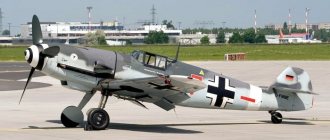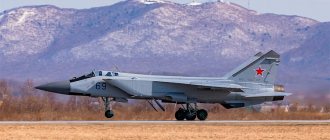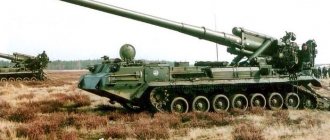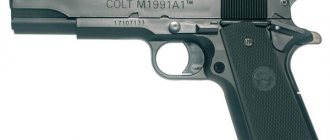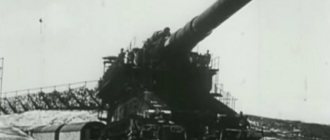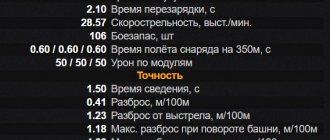| MiG-19 | |
| Type: | Fighter |
| Developer: | OKB 155 |
| Manufacturer: | Aircraft plants No. 21 (Gorky), No. 153 (Novosibirsk), Aero Vodochody (Czechoslovakia), Shenyang Aircraft Plant (SAIC), (China) |
| First flight: | May 24, 1952 (SM-2/1), February 5, 1954 (SM-9/1) |
| Start of operation: | 1955 |
| End of use: | USSR 1989, China 2010 |
| Status: | Withdrawn from service |
| Main operators: | USSR Air Force, Chinese Air Force |
| Years of production: | 1955 — 1960 |
| Units produced: | ~6500 |
| Base model: | MiG-17 |
MiG-19 is a second-generation Soviet single-seat jet fighter developed by the Mikoyan and Gurevich Design Bureau in the early 1950s. The first Soviet serial supersonic fighter, it was widely used in the USSR air defense system and was supplied abroad. The same age as the American F-100 Super Saber fighter, although in Vietnam it also competed with the later F-4 Phantom II. According to NATO codification: Farmer , Farmer - English. Farmer.
Development history
The first step towards the creation of the supersonic MiG-19 fighter can be considered the experimental SM-1 aircraft. By decree of the Council of Ministers, dated April 20, 1951, the old MiG-15bis 45°, which paved the way for the creation of the MiG-17, was converted to install two AM-5 engines instead of one VK-1. The engines were located in the fuselage, in the engine compartment, close to each other. During the tests, it was planned to improve the flight characteristics of the MiG-17 and bring the engine to the required level of reliability and efficiency. Initially, the SM-1 was equipped with two AM-5 engines (later they were replaced with improved AM-5A) with a thrust of 2000 kgf. In total, the two engines, even without afterburner, provided more thrust than one VK-1F with afterburner, while their total mass was only 88 kg more. The smaller dimensions of the engines made it possible to place three additional tanks in the fuselage with a total volume of 770 liters.
The aircraft was built at the end of 1951 and received the designation I-340. Flight tests were carried out by pilots G. A. Sedov and K. K. Kokkinaki, and A. V. Minaev was appointed lead test engineer. During testing, the aircraft reached a speed of 1193 km/h at an altitude of 5000 m and a climb rate of 41 m/s. Thanks to more efficient engines and increased fuel capacity, the fighter's range has significantly increased.
The next stage in the development of the MiG-19 was the creation in 1952 of the SM-2 (I-360) aircraft. The new aircraft differed from the SM-1 in that the fuselage was extended by 1.6 meters, the wingspan decreased from 9.26 meters to 9.04 meters, and the weight increased from 5219 kg to 6802 kg. A new wing with a 55° sweep and one aerodynamic ridge was developed for the SM-2. At the suggestion of engineer N. Volkov, N-37D guns with ammunition were placed in the root part of the wing. This made it possible to free up space in the forward fuselage for other equipment. Other changes affected the design of the canopy, the main landing gear and their flaps, the lower fin was enlarged, and the landing light was moved from the left wing under the nose. The power plant consisted of two AM-5A engines.
In April 1952, the first prototype with a T-shaped tail, designated SM-2/1, was transferred to the LII airfield, where on May 27 G. A. Sedov performed its first flight. Almost immediately it became clear that the thrust of the AM-5A engines was not enough, and they were replaced with forced AM-5Fs with a thrust of 2150 kgf and 2700 kgf in afterburner. With the new engines, it was possible to reach a speed of M=1.19 in horizontal flight. Based on the test results, the horizontal tail was moved to the fuselage, while its area was increased, the rudder area was also increased and the brake flaps were modified. The converted aircraft was designated SM-2A, and after increasing the aerodynamic ridges on the wing - SM-2B.
The second prototype, SM-2/2, was originally built with a horizontal tail on the fuselage. In addition, the SM-2/2 was equipped with guns with a short barrel and there was no possibility of mounting a 760-liter PTB.
However, even the uprated AM-5F engine was not powerful enough, and the prototypes were re-equipped with new, more powerful AM-9B with a thrust of 2600 kgf and 3250 kgf in afterburner. After being put into production, this engine was designated RD-9B. With the new engine, the SM-2B received the designation SM-9/1. On January 5, 1954, test pilot G. A. Sedov took the SM-9/1 into the sky for the first time; in total, he completed 132 flights on this machine. Already on the second flight the sound barrier was broken.
By that time, the designers had changed the shape of the partition in the air intake, and the N-37 cannons were replaced with three HP-23s, with a total ammunition load of 340 rounds. The equipment included the RSIU-3M “Klen” radio station, the “Uzel-1” transponder and the SDDM-1M “Konus” radio range finder.
On September 12, 1954, factory tests were completed, and state tests began on September 30. Flight tests showed that the aircraft's performance had improved significantly, and the SM-9/1 was recommended for adoption. The Council of Ministers, by resolution No. 286-133 of February 17, 1954, ordered the start of serial production of the MiG-19 aircraft at two factories in Gorky and Novosibirsk.
Design
The MiG-19 fighter is a classic all-metal single-fin mid-wing aircraft. The semi-monocoque fuselage consists of easily detachable nose and tail sections. In the bow there is an air intake, compartments with avionics, a pressurized pilot cabin and a nose landing gear.
The pilot's cabin is protected by armor: the thickness of the armored glass is 64 mm, the front bulkhead is 10 mm, and the armored back is 16 mm. An ejection seat is installed in the fighter's cockpit.
The tail section is occupied by fuel tanks and engines. The standard MiG-19 was equipped with two AM-9 (RD-9) turbojet engines - each with a 9-stage axial compressor, 2-stage turbine and afterburner. Brake flaps are installed on the sides of the hull and underneath it, and there is also a brake parachute.
The all-metal wing with a sweep angle of 55 degrees is equipped with flaps and spoilers. The horizontal tail in the production MiG-19 is all-moving, vertical, and consists of a fin with a stabilizer and a ridge under the fuselage of the fighter.
The MiG-19 control system with hydraulic drives was advanced and very effective for its time. The chassis braking system, weapon reloading, and emergency canopy release were carried out using an on-board pneumatic system.
The aircraft's navigation equipment included a radio compass, a radio altimeter, and a "friend or foe" system. The range of the RSIU-4 radio station was up to 350 km. In addition, the MiG-19 was equipped with a radar exposure alarm.
The original MiG-19 fighter's built-in armament consisted of three 23mm automatic cannons (later mostly replaced by 30mm cannons). Two guns were located in the root of the wing, the third was in the nose of the fuselage. The ammunition load was 70 shells per gun. The rate of fire of each gun is 900 rounds per minute. If necessary, the MiG-19 of the first modification could carry ASR-57 unguided missiles and free-falling bombs of up to 250 kg caliber.
The MiG-19 control system with hydraulic drives was advanced and very effective for its time
Prototypes
- SM-1 (I-340) : Experimental MiG-17 with two AM-5 (later AM-5A) engines. It was used to develop the layout of the power plant, which was later used on the MiG-19.
- SM-2/1 (I-360) : First prototype of the series, with two N-37D cannons and two AM-5A (later AM-5F) engines. It was distinguished by a T-shaped tail.
- SM-2/2 (I-360) : The second prototype of the series, the horizontal tail was located on the fuselage.
- SM-9/1 : With two RD-9B engines, prototype of the MiG-19.
- SM-9/2 : With two RD-9B engines, prototype of the MiG-19S.
- SM-9/3 : Experienced, with three HP-30 cannons instead of 3 HP-23.
- SM-9/3T : Converted for testing K-13 (R-3s) missiles.
- SM-9V : Prototype of the MiG-19SV.
- SM-7/1 : With RP-1 "Izumrud" radar, MiG-19P prototype.
- SM-7/2 : With all-moving tail and two ORO-57K NURS blocks.
- SM-7/M : With RP-2U "Izumrud-2" radar and four RS-2-U missiles, prototype MiG-19PM.
VHF radio station RSIU-4 (Oak) instead of RSIU-3.
On the MiG-19S, changes were also introduced in the power plant, control system, braking system, and braking parachute system, and therefore the design of the wing and fuselage was significantly modified. The ventral brake flap was deflected at an angle of 45, and the deflection angles of the rear brake flaps were limited to 25. As a result, the set of design changes carried out made it possible to significantly improve the maneuverability and controllability of the aircraft. The fighter has become much more enjoyable to pilot, especially when performing vertical maneuvers.
Despite the large number of modifications implemented on the MiG-19S, the fighter still continued to present unpleasant surprises. Numerous disasters did not contribute to the growth of the car's popularity. On production aircraft, a defect related to the automatic control adjustment (ACC) and hydraulic units of the control system again appeared. There were also many cases of failure of hydraulic boosters. This happened not only during the commissioning tests, but also during the operation of the nineteenth in combat units. Only after changes were made in the design of the hydraulic boosters themselves, it was possible to get rid of this defect.
Page
Modifications
Below are the modifications of the MiG-19, which were mass-produced in the USSR.
- MiG-19 (1955) - First production version. Armament: three 23-mm NR-23 cannons. Deliveries to the troops began in March 1955. And already on July 3, 48 new MiGs took part in the air parade in Tushino. Total workshops until the end of 1955.
- MiG-19S (1955) - A fighter with an all-moving stabilizer (hence the letter “C”), three 30-mm NR-30 cannons, updated avionics and improvements in airframe design.
- MiG-19P (1955) - All-weather interceptor with RP-1 Izumrud radar and two HP-30 cannons (on the first production vehicles - HP-23). In later series, the RP-5 Izumrud-2 radar was installed.
- MiG-19PG (1955) - MiG-19P with data transmission and ground guidance equipment "Horizon-1".
- MiG-19R (1956) - Reconnaissance aircraft based on the MiG-19S with RD-9BF-1 engines, two NR-30 cannons and AFA-39 cameras in place of the third.
- MiG-19SV (1956) - High-altitude interceptor with a lightweight design, two NR-30 cannons and RD-9BF-1 engines.
- MiG-19PM (1957) - Interceptor without cannon armament, with four RS-2U guided missiles and RP-2U Izumrud-2 radar.
- MiG-19PML (1958) - MiG-19PM equipped with a Lazur ground guidance station.
- M-19 (M-19M) - radio-controlled target aircraft.
MiG-19 Dimensions. Engine. Weight. Story. Range of flight. Service ceiling
The history of the MiG-19 has been documented since July 30, 1950. On that day, at a meeting in the Kremlin, I.V. Stalin raised the question of creating fighters with a range greater than that of the MiG-15 and MiG-17. The development of two types of twin-engine vehicles was envisaged: an all-weather interceptor with a powerful on-board radar and a maneuverable front-line fighter. The most important stage in the creation of the MiG-19 fighter was the SM-2 aircraft, which became an experimental testing ground for achieving supersonic flight speeds.
Experimental aircraft
- SM-10 : Experimental, with refueling system.
- SM-11 : Experienced, with Yastreb-SIV IR station.
- SM-12/1 : Experimental, with RD-9BF turbofan engine, air intake with a sharp leading edge and a central adjustable cone.
- SM-12/2 : Experienced, with R-3-26V turbofan engine with water injection system.
- SM-12/3 : Experimental, with R-3-26 turbofan engine, fuselage nose section extended by 670 mm and with a 2-position cone in the air intake.
- SM-12/4T : Experimental, for testing the K-13 missile launcher.
- SM-12PM : Experienced, with R3-26 engines, TsD-30 radar in the air intake cone, two R-2-US guided missiles and U-19M launch boosters.
- SM-12PMU : Three experimental aircraft with R3M-26 engines, TsD-30 radar in the air intake cone, K-5 guided missiles and U-19M launch boosters.
- SM-20 : Experienced, for testing X-20 missiles.
- SM-K : Experienced, for testing the X-20 missile control system.
- SM-21 : Experienced, for testing the S-21 unmanned aerial vehicle.
- SM-24 : Experienced, for testing the S-24 unmanned aerial vehicle.
- SM-30 : Experimental, with PRD-22 booster for take-off from a ground ejection launcher.
- SM-50 : Five experimental vehicles with U-19D booster.
- SM-51 : Experienced, with U-19D booster.
- SM-52 : Experienced, with U-19D booster and Almaz radar
- SM-52P : Experimental, for testing the Horizon-1 equipment.
- SM-6 : Experimental, for testing K-6 missiles.
- SL-19 : Laboratory aircraft with ski landing gear.
- MiG-19SMK : Experienced, for testing the K-10 missile launcher.
Combat use
USSR and post-Soviet space
Soviet MiG-19s were used to intercept border violators. They repeatedly tried to intercept American U-2 reconnaissance aircraft, but without any success. These attempts ended in tragedy: on May 1, 1960, during another interception flight, one MiG-19 was mistakenly shot down by an S-75 air defense missile, its pilot Sergei Safronov was killed. The first victory on the MiG-19 was won on July 1, 1960 in the Arctic - captain V. Polyakov shot down an RB-47 reconnaissance aircraft. In the late 50s and early 60s, a significant number of balloons with reconnaissance equipment were shot down by MiGs. Many combat episodes fell on the MiG-19 pilots of the Soviet 24th VA, stationed on the territory of the GDR. On May 20, 1960, a couple consisting of Mr. L. Shkaruba and Art. Lieutenant M. Krylov was forced to land by the RB-47 reconnaissance aircraft. After some time, the offender was released. Another such reconnaissance aircraft shot down a Soviet MiG-19 in 1963. On April 2, 1963, a pair of MiGs fired at a Cessna 310 that had gone beyond the southern Berlin corridor and forced its pilot to land. On January 28, 1964, a US Air Force T-39 Sabreliner was destroyed (the crew died).
Soon the MiG-19 pilots won another, more impressive victory. The events that took place on March 10, 1964 seem to have developed so rapidly that the crew of the American reconnaissance aircraft RB-66 did not even have time to realize what had happened. On that day, a major GSVG exercise was held at a training ground near Magdeburg in the GDR, and a group of military commanders led by Marshal A.A. arrived to observe it. Grechko and Air Chief Marshal K.A. Vershinin. When there was very little time left before the start of “combat operations” of the prepared troops, the Deputy Commander-in-Chief of the GSVG for Aviation was informed about an intruder aircraft that had appeared in the air. Apparently, against the background of the expected fuss, the American intelligence officer hoped to pass unnoticed over the object of interest to him and return home safely. However, these calculations did not come true. First, the plane was intercepted by a MiG-19S captain F.M. Zinoviev from the 33rd IAP, taking off from the Wittstock airfield. Zinoviev fired at the intruder with cannons. Then a pair of MiG-19s from the 35th IAP were aimed at the American car. The weapons on B. Sizov’s plane failed, but captain V.G. Ivannikov first fired a salvo with S-5 rockets, and then finished off the scout with cannons. The crew of the RB-66 bailed out. For a long time it was believed (based on rumors circulating due to total secrecy) that this victory was won on the MiG-21F-13, which the regiment began receiving in the fall of the same year.
China
Since the mid-1960s, J-6s have become the main means of protecting the air borders of the PRC. From 1964 to 1971, Chinese Air Force and Navy pilots in the J-6 destroyed 21 intruders, including: two F-4 Phantom II, two A-6 Intruder, two RF-101 Voodoo, one F-104 Starfighter and A -3 Skywarrior. The battles did not always end successfully. So, in 1965, a J-6 group attacked a US Air Force C-130 over the sea. The Hercules crew requested help and the Phantoms of the US 7th Fleet arrived in time and forced the MiG pilots to move towards the coast. Even worse, the battle with Taiwanese F-104Cs in 1967 ended with the loss of two fighters. During the period of deterioration of the situation on the Soviet-Chinese border, J-6 repeatedly flew 1-1.5 km deep into the territory of the USSR. In January 1974, they provided air cover for the Chinese landing on the Paracel Islands. In March 1979, they were used sporadically during the intervention of the PRC army in the northern provinces of Vietnam. Faced with well-equipped air defense, the Chinese lost at least one aircraft of this type. However, even after the withdrawal of troops from Vietnam, Chinese MiGs repeatedly invaded their neighbor’s airspace.
Vietnam
Vietnam received J-6 fighters (Chinese copies of the MiG-19), which entered service with the 925th Fighter Wing. The DRV Air Force command designated the Yenbai airfield as the base location. In April 1969, there were nine J-6 aircraft. It became combat-ready only in the spring of 1972 and was used for air cover against Allied air attacks. The 925th pilots defended the Thakba hydroelectric power station.
Vietnamese J-6s managed to take part in combat for the first time on May 8, 1972. In the morning, radars detected four targets at an altitude of 5000 meters, towards Yenbai. First a pair of MiG-21s from the 921st regiment, and then a flight of J-6s from the 925th, were raised to meet them. The latter discovered four F-4 Phantom aircraft. The Americans' attempt to use guided missiles failed - the enemy successfully evaded them. The Vietnamese came within range of cannon fire, and now the Phantoms, which had no guns, became targets. Two American fighters were damaged. One of them flared up and began to dive, but it was not possible to trace its fate - the Vietnamese were running out of fuel. The J-6s returned home without loss.
The Vietnamese constantly studied the tactics of enemy aircraft and analyzed the course of air battles. Targeted interrogations of downed American pilots were conducted. It turned out that the latter are trying to avoid horizontal battles with the more maneuverable MiG-17 and MiG-19, transferring the battle to verticals. It should be taken into account that the Soviet fighter, due to its higher thrust-to-weight ratio, also had a better rate of climb. The Americans entered the battle in highly open battle formations. In the event of a fight with a single “mig,” the Americans acted as a group; when encountering several “migs,” they split into pairs, trying to force a duel situation on the enemy.
The Allies had enormous numerical superiority; sometimes it was difficult for the Vietnamese to even take off. The battle began just a few seconds after leaving the runway. But even under these conditions, the J-6 pilots won victories. On May 10, 1972, Vietnamese pilot Pham Hong Son was able to hit the Phantom from a distance of two kilometers, and then finished it off at point-blank range. The F-4E crew was killed. Pilot Nguyen Manh Thang fired twice at the F-4D, whose pilot managed to eject before his fighter exploded. The second crew member was blown to pieces along with the car. Eight Vietnamese pilots fired a total of 1,050 rounds. One J-6, damaged by the Americans, crashed on approach. Another car was destroyed by its own anti-aircraft missile. Another J-6 landed without fuel with its engines stalled, but its pilot escaped with bruises. And another one landed too quickly, rolled off the runway, slammed down and exploded. Due to the inequality of forces, the Vietnamese suffered heavy losses. On May 18, two J-6s had to fight a dozen Phantoms. Both Vietnamese fighters were shot down by Sidewinder missiles.
In July - August 1972, the pilots of the 925th regiment failed to achieve victories in air battles. In September - October, J-6s conducted three air battles, in which they shot down two enemy aircraft. According to the DRV Air Force, the regiment's losses during this period amounted to three J-6s; according to American data, four aircraft of this type were shot down: September 2, September 9 (two aircraft) and October 6.
In general, from information published in the USA it follows that during the war the Americans shot down eight J-6s, all by Phantom crews, one of them with F-4E guns, the rest with missiles. The Vietnamese claimed seven J-6 aerial victories (three confirmed and four unconfirmed), all over Phantoms.
According to some reports, in 1979, Vietnamese and Kampuchean F-6s repeatedly took part in air skirmishes. It is not worth talking about the victories of one side or another because of the contradictory information.
Egypt
On November 29, 1966, two Egyptian MiG-19S were shot down by an Israeli Mirage fighter. Egypt used the MiG-19 during the Six-Day War in 1967. Israel claimed to have shot down 14 (13 confirmed) Egyptian MiG-19s in air battles; the Egyptians' successes look much more modest - they claimed 3 air victories (1 confirmed). On May 19, 1969, during a war of attrition, an Egyptian MiG-19 intercepted two Israeli Mirage IIIs; in an air battle, the Egyptian shot down one Mirage and the other flew away.
Syria
Syria also used its MiG-19s during the Six Day War. On June 5, 1967, a Syrian MiG-19 shot down an Israeli Mystere fighter. On June 6, a Syrian flying a MiG-19 damaged an Israeli Super Mystere B2 with cannon fire. The Syrian “nineteenth” had no losses in air battles.
Pakistan
Like Vietnam, the Pakistani air force did not receive the original MiG-19s, but their Chinese copies - the J-6 (F-6). Pakistan received the first 74 aircraft in 1966, and by the end of the year the country’s air force already had three combat-ready squadrons armed with these fighters. Two more batches of aircraft were purchased from China after the Indo-Pakistani War of 1971: 60 fighters in 1972 and another 60 in 1977. In total, about 260 Chinese MiG-19s were delivered here. In the 1970s Modern Western aircraft - the F-104 and the Mirage III - appeared in service with the Pakistani Air Force. It is somehow not customary to compare these fighters with the MiG-19: they say they are different generations and level of technology. Pakistani pilots compared. The result of this was precisely the batch of six dozen F-6s received from China in 1977. The pilots unanimously noted the excellent maneuverability of the MiGs at low and medium altitudes and the high reliability of their systems.
The largest conflict involving the F-6 was the Indo-Pakistani War of December 1971. Pakistani F-6 pilots have flown about 650 combat interception and air patrol missions. F-6 pilots carried out another 184 sorties to attack ground targets. At its inception, these aircraft were in service with the 15th, 19th and 25th squadrons of the Pakistan Air Force. The first prey of the F-6 pilots was Hunter, destroyed by Lieutenant J. Quazi on December 4 near Mianwali. On the same day, while repelling Indian air raids on airfields, Lieutenant K. Latif shot down and Lieutenant Sharfraz damaged a Su-7B. Three days later, in a battle with four Su-7Bs, Lt. Atig and Mushaf destroyed another aircraft each. In total, according to official Pakistani data, the F-6s shot down: 1 MiG-21, 6 Su-7B, 2 Hunters and damaged four more Indian aircraft. The most successful pilot was Wing Commander (Lieutenant Colonel) S. Khatmi, who scored three victories (taking into account the 1965 war, 5 shot down). The loss of four F-6s was admitted: one in air combat and three from ground air defense (one of them from their own). The Indian Air Force announced the destruction of eight F-6s and did not admit that not a single Su-7B was shot down in battles with fighters (according to other sources, the Indians admitted that two of their Su-7s were shot down by Pakistani F-6s) and denied the loss of a MiG-21 in a battle with Pakistan MiG-19. Later, the Indians were able to prove the shooting down of three F-6s in air battles (2 MiG-21s and 1 Su-7 were shot down), the Pakistanis were able to prove six F-6 air victories (3 Hunters and 3 Su-7s).
After the entry of Soviet troops into Afghanistan in 1979, F-6s were used to protect Pakistan's air borders from Afghan and Soviet aircraft. At first, such incidents ended in the ousting of the violators, and later in armed clashes. On April 12, 1986, Pakistani F-6s unsuccessfully attacked 3 Soviet Su-25s.
Other countries
F-6s took part in the confrontation between Iran and Iraq, with pilots from both countries using these machines both to carry out attacks on ground targets and to protect rear targets from the air.
Chinese F-6s have spread across almost the entire African continent. They were used in various local armed conflicts, in particular in Somalia, Sudan, Tanzania and Uganda.
On June 8, 1980, a Zambian Air Force J-6 shot down an Angolan Yak-40 passenger plane. 19 people died.
Where are the predicted millions of corpses in the “third world” countries?
The millions of corpses predicted in the Western media in the “least developed” countries of Africa, Asia, and Latin America are not being discovered. Thus, there is no epidemic in India, Vietnam, and other countries in Southeast Asia, because the region has been growing steadily in recent years.
India has outpaced China, which was experiencing an economic crisis long before the pandemic: GDP growth has not shown its target level for a decade. By the beginning of 2022, Beijing had lost the trade war with the United States, concluding an enslaving agreement on tariffs, the withdrawal of American enterprises from the Middle Kingdom was planned, so the start of quarantine measures turned out to be very conveniently timed to coincide with the traditionally long celebration of the New Year according to the Eastern calendar.
In Latin America, “vegetating and starving”, denigrated in the Western media, Venezuela consistently registers few cases of the disease (414 cases as of May 10), although qualified Cuban doctors work there. Authorities say 46.6% of patients recover, 98% of cases are asymptomatic or patients have mild symptoms.
But the “flagship of democracy” of the continent - Brazil, which after the election of President Jair Bolsonaro cannot get out of the economic crisis, is once again falling apart in protests between supporters and opponents of quarantine measures, showing one of the highest infection and mortality rates in the region - 155,939 people infected and 10,627 deaths as of May 10.
In service
- Albania - In October 1959, 15 MiG-19PM were delivered to Albania. The aircraft were received by the 7594th IAP at Rinas air base. In 1965, they were exchanged with China for F-6 fighters.
- Afghanistan - The Afghan Air Force received 18 MiG-19S in 1965.
- Bangladesh - Since 1977, the Bangladesh Air Force began receiving Chinese-made F-6 fighters; two squadrons were armed with these aircraft. In 1981, FT-6s were purchased for pilot training; before that, FT-5s were used. In 1998, the fighters were withdrawn from service, but the trainers still remain in service and are used to train A-5III fighter-bomber pilots.
- Bulgaria - At the beginning of 1958, Bulgaria received 24 MiG-19S fighters, where they were operated until 1978. In 1966, Bulgaria received from Poland its former MiG-19P and MiG-19PM. At the Dobroslavtsy airbase they were used until 1975.
- Hungary - In March-April 1960, 12 MiG-19PMs entered the 3rd squadron of the 31st IAP Air Defense of Hungary. Before they were withdrawn from service in 1974, three aircraft crashed and two pilots were killed.
- Vietnam - In 1968-1969, Vietnam received 54 F-6s, which were armed with the 925th Fighter Wing. During the war, the air regiment suffered significant losses and in 1974 China transferred another 24 F-6s to the Vietnamese side.
- GDR - In October 1959, the 2nd Squadron of the 3rd Air Regiment received the first of 12 MiG-19S fighters, and the 1st Squadron received the same number of MiG-19PMs. 11 aircraft were lost in various incidents.
- Egypt - In 1958-1967, the Egyptian Air Force received 160 MiG-19S. After breaking off relations with the USSR in 1976, Egypt established close contacts with China, where a large number of F-6s came from. The fighters were in service with the 241st and 242nd brigades. Egyptian F-6s were modified to use Matra Majik air-to-air missiles.
- Zambia - The Zambian Air Force received 12 F-6s in 1977.
- Indonesia - In 1961, the Indonesian Air Force purchased MiG-19F fighters from the USSR. In this modification, the aircraft differed slightly in the composition of its avionics from the serial MiG-19S. In 1970, relatively new MiG-19s were sold to Pakistan.
- Iraq - In the mid-60s, Iraq received 15 MiG-19S. Another forty F-6s were delivered to Iraq in 1983 from Egypt; the Iraqi Air Force was supposed to use it to directly support troops, but preference was given to the Mi-24 attack helicopter. As a result, F-6s were transferred to training and reserve units.
- Cambodia - In 1977, 16 disassembled F-6s were delivered to Kom Phong Chnang airfield. For various reasons, only six of them were assembled and flown.
- DPRK - About a hundred F-6s made in China.
- China - Along with the license for the production of MiG-19S/P/PM, in 1959 China received five MiG-19P and five MiG-19PM in disassembled form. Under the designation J-6, the fighter was mass-produced in Shenyang and Nanchang.
- Cuba - In November 1961, the first 8 of 12 MiG-19P interceptors arrived in Cuba. They were in service with the Cuban Air Force for a relatively short time and were already replaced by the MiG-21PFM in 1965.
- Pakistan - On November 24, 1965, Islamabad and Beijing signed an agreement to supply 72 F-6s, and on December 31 of the same year, the first fighters arrived in Pakistan. Indonesia sold 20 Soviet MiG-19S to Pakistan. Two more batches of 60 F-6s were received in 1972 and 1977. Together with the FT-6 trainers, the total number of MiGs received by Pakistan was about 260 aircraft. The number of combat-ready fighters of this type reached its peak in 1981, when they were in service with 9 squadrons of the Pakistan Air Force. Many Pakistani F-6s have been upgraded to use AIM-9 Sidewinder missiles. The last unit to have F-6s in service was the 23rd Fighter Squadron of the Pakistan Air Force, which was replaced by more modern F-7PGs in early 2002 with F-6 fighters. The ceremonial decommissioning of the last F-6 took place on March 27, 2002.
- Poland - In the summer of 1958, the first of 12 MiG-19Ps were received by the 28th IAP of the Polish Air Force, stationed in Slupsk-Redzikovo, where they remained until 1966, after which they were transferred to Bulgaria. In 1959, the Polish Air Force received 13 MiG-19PM, distributed between the 28th and 39th IAP. The aircraft were operated until 1966-67, when they were transferred to Bulgaria.
- Romania - Romania acquired 10 MiG-19Ps in 1959 and 5 in 1960. They were operated by the 66th NAD at Deveselule until the early 70s. Subsequently, Romania acquired another 45 MiG-19PM. They were used in the 66th NAD until the mid-70s.
- Syria - 1958-1962 The Syrian Air Force received 40 MiG-19S.
- Somalia - About 50 Chinese-made F-6s.
- Sudan - The Sudanese Air Force has received six F-6s, which they use as attack aircraft.
- Tanzania - The Tanzanian Air Force received 12 F-6s in 1974.
- At the end of 1957, Czechoslovakia received 27 MiG-19P interceptors, which entered the 1st and 11th IAP. In 1958, 12 MiG-19S entered service with the Czechoslovak Air Force, arriving in the country in December 1957. The aircraft were distributed between the 1st and 11th fighter wings. Subsequently, the MiG-19 was built in Czechoslovakia by Aero Vodochody under the designation S-105. In 1959-60, the Czechoslovak Air Force received 33 MiG-19PM interceptors, which were in service until the early 70s.
There is no Covid pandemic, there is a fear pandemic
If you take Africa, there is no epidemic there, and there is no panic. Africa was a model for testing the Ebola scare pandemic a few years ago, and the experiment went well. Now, residents of unstable countries considered “world powers” are frightened by identical consequences - multiple deaths.
Meanwhile, countries that are economically and politically stable in Europe - Sweden, Belarus - do not experience any problems. There, COVID-19 is treated like a flu disease, and statistics show that nothing beyond the normal flu epidemic is happening. By the way, both countries on many issues do not block with the “masters” of this world - Russia and the USA; Sweden is not part of the eurozone.
Performance characteristics
Specifications
- Crew: 1 pilot
- Length: 12.54 m with pitot tube: 14.64 m
- Non-afterburning thrust: 2 × 2600 kgf (25.5 kN)
Flight characteristics
- Maximum permissible speed: M=1.6
- Maximum speed: 1452 km/h at 10,000 m
- Lift-off speed: 280-305 km/h
- Landing speed: 235 km/h
- Practical range: 1400 km / 2200 km with PTB
- Flight duration: 1 hour 43 minutes / 2 hours 38 minutes with PTB
- Service ceiling: 15,600 m afterburner: 17,500 m - 17,900 m
- 10000 m in 1.1 min
- in afterburner: 515 m without PTB
- with parachute: 610 m
- with PTB: 5 g
Armament
- Small arms and cannon: 3 × 30 mm NR-30 cannons with 201 rounds.
- Hanging points: 2-4
- Guided missiles: up to 4 × RS-2U for MiG-19PM
- Unguided rockets: 2-4 × blocks of 16-32 rockets
- Bombs: 2 × 50 kg to 250 kg bombs
Advantages and disadvantages
The MiG-19, in comparison with its direct American counterpart, which appeared a year later, the F-100 Super Saber fighter, had significant advantages:
- Was about 3 tons lighter;
- Had a 200 km longer range of action;
- Developed a higher maximum speed (1450 km/h versus 1215 km/h);
- It was almost twice as fast in terms of climb rate.
The disadvantages of the MiG-19 are usually attributed to the relatively frequent failures of on-board equipment (especially the radar), but at that time almost all “second generation” fighters faced similar problems. Compared with the same “Super Saber”, the MiG-19 could be cited as an example of reliability.
In terms of climb rate in afterburner mode, as well as maneuverability, the MiG-19 was considered one of the best fighters in the world until the early 1970s. Even opponents noted these features of the MiG-19 when they engaged in air combat with them in machines classified in the West as the “third generation.”
The Pakistan Air Force, having received more modern Western aircraft (the F-104 and Mirage III) in the 1970s, ultimately preferred modified Chinese versions of the MiG-19, keeping them in service until 2002. According to Pakistani pilots, MiGs have higher reliability of their systems, good survivability and excellent maneuverability at low and medium altitudes.
Surviving copies
- Taganrog Museum of Aviation Technology
- Museum of Air Defense Forces
- Airplane monuments in Dnepropetrovsk on the street. Malinovsky (Solnechny residential area) and before entering the military town near the airport.
- Kurgan Aviation Museum.
- Airplane monument in Ufa in the courtyard of UGATU
- Airplane monument in Kaliningrad near the former KVATU
- Airplane monument in St. Petersburg in Aviator Park
- Airplane monument in Lipetsk on Aviator Square
- Airplane monument in Sevastopol on Ostryakova Avenue
- Minsk Museum of Aviation Technology of the Central Aero Club DOSAAF
- State Aviation Museum in Kyiv
- Airplane monument in Novograd-Volynsky (Zhytomyr region)
- Airplane monument in Khabarovsk. Large airfield.
- Airplane monument in Khartsyzsk, Ukraine.
- Airplane monument in Donetsk, Ukraine.
- Airplane monument in Sevastopol, Lyubimovka, Belbek garrison, Crimea
- Airplane monument in the village. Krasnokutsk, Kharkov region, Ukraine
- Airplane-monument Krasny Luch, Lugansk region, Ukraine
- Airplane monument, Lodeynoye Pole, Leningrad region.
- Airplane monument in the village of Ugolnye Kopi, Anadyr region, Chukotka
- Airplane monument near the turn to the airport in Kherson, Chernobaevka village, Ukraine
- Airplane monument Dubno, Ukraine
- Airplane monument in Svetlovodsk, beginning of Gagarin Street, Ukraine
- Airplane monument in Staraya Russa, Novgorod region, on the street. Red Commanders
- Airplane monument of Veliky Novgorod on the street. Bolshaya St. Petersburgskaya
- Airplane monument in Shchuchin, Belarus on Ostrovsky Street
- Airplane monument in Kresttsy village, Novgorod region.
- Airplane-monument of the village of Zapadynka (Vasilkov, Ukraine) garrison of the 19th division of the 8th air defense army
